
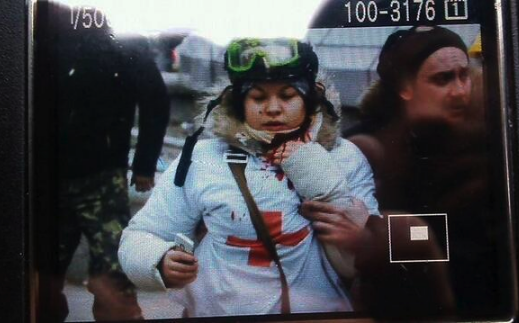
Snipers shooting even at women, journalists and medics in Kiev.
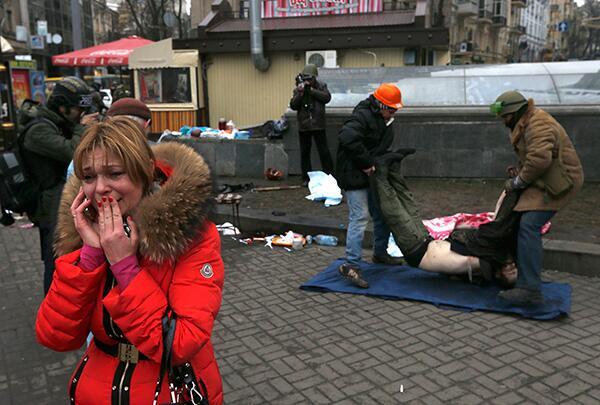
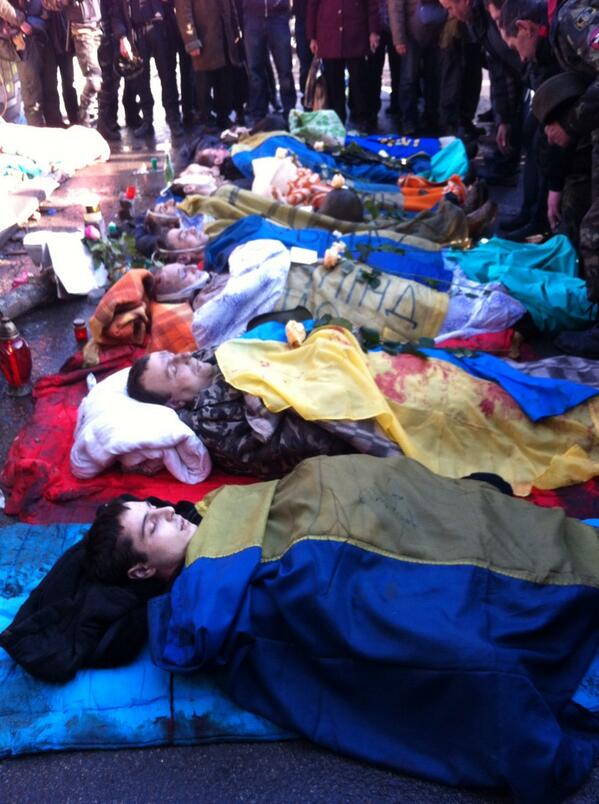
Radio Svoboda, the Ukrainian service of the Radio Free Europe/Radio Liberty network (which is funded by the United States government), also posted a series of archived clips on YouTube, including some that showed a government sniper in position and shots being fired by armed officers as the city erupts, once more, in deadly violence.
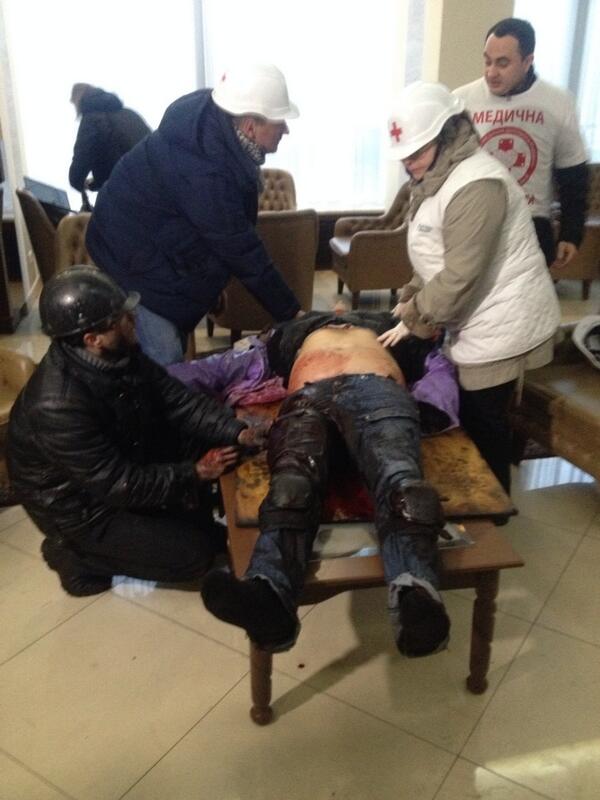
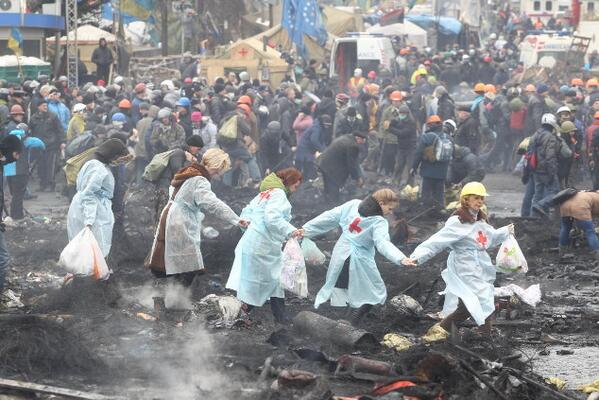
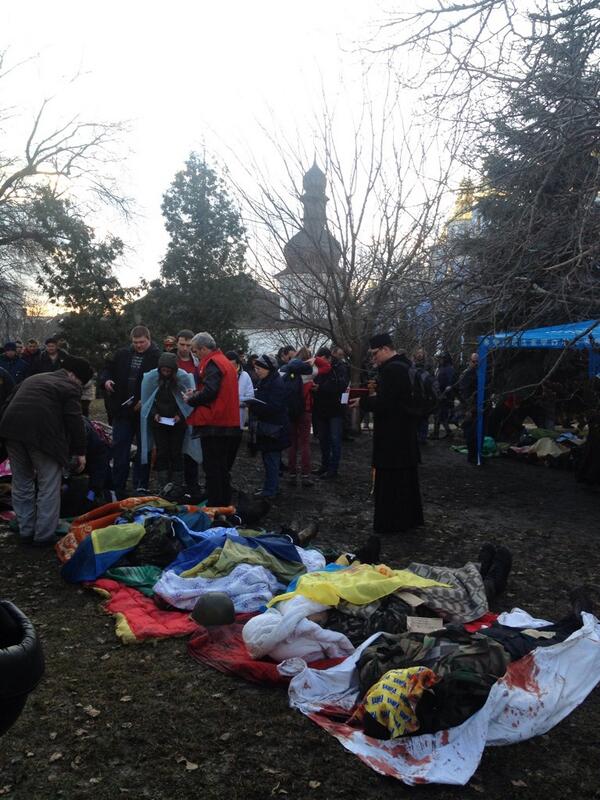
Blood and black ash smeared the once-pristine floors of Kiev’s Hotel Ukraine. Dining tables, hastily shoved together, became makeshift hospital beds for the injured; the cold ground was a crude morgue. A priest knelt next to one man, offering what small comfort he could.
On the bloodiest day in modern Ukrainian history, the 12 lifeless, unnamed men who lay on the floor of the hotel lobby this morning, their bodies loosely covered with sheets, were just a few of the dozens killed in a conflict that has transformed the centre of Ukraine’s capital into a brutal battleground.
They had been hit by police sniper bullets in the head, heart, lungs and neck. Police had prevented doctors from treating the injured immediately.
“We may have been able to save the lives of some of them,” said one of the doctors present at the scene.
Dressed all in black, their faces hidden behind balaclavas, men in police uniforms were seen firing shots into the crowds that flooded the streets around the protest camp at Independence Square, also known as the Maidan. From fortified positions on the ground and on the roofs of buildings, some appeared to take time to line up their targets. Others fired indiscriminately, taking shots at groups of men crouching under metal shields. Teams of protesters and volunteer medics carried the injured away on planks of wood.
Amid the chaos on the streets, political leaders met with Ukrainian President Viktor Yanukovych to try to stem the bloodshed. He insisted that police were not armed and “all measures to stop bloodshed and confrontation are being taken.”
Soon afterwards, the acting interior minister, Vitaly Zakharchenko, issued a statement saying: “Police have been given combat weapons, which will be used in accordance with the law.” The Interior Ministry warned the residents of Kiev to stay indoors because of the “armed and aggressive mood of the people”.
Ukrainian authorities said that more than 75 had been killed in the clashes this week. Some of the anti-government protesters had come to the Maidan wielding clubs, axes and guns to face off against the country’s feared elite police units known as the “Berkut”. Radical protesters, including members of far-right groups, have been active in the violence.
But others – the students, the young professionals, the “babushkas” (grandmothers), who had begun their protests peacefully in November – are now gathering rocks to use as ammunition for the men at the towering barricades that defend the protest camp. As fighting continued on the square, a group of six elderly women worked under the cover of a bus stop to prepare Molotov cocktails.
“This is extremism,” one of the women said, refusing to give her name. “Our president has driven us to this. No more cooking in the kitchen for us. Now we make these.”
The violence that has brought the country’s capital to its knees has been long in coming. Outside Ukraine, this is seen by many as a clash of East versus West, a power battle between Russian President Vladimir Putin’s controlling Kremlin and an expanding EU, played out in a deeply divided post-Soviet nation. While parts of the country – mostly in its western cities – are in open revolt against Mr Yanukovych’s government, many in the mostly Russian-speaking east favour strong ties with Russia.
Although the protests began after Mr Yanukovych spurned a historic trade and political deal with the EU in favour of a nine billion financial bailout from the Kremlin, for many Ukrainians this is a fight for basic freedoms.
Opposition leaders have called for the reinstatement of the country’s 2004 constitution, to strip the president of sweeping powers, and they demand early elections, currently scheduled for 2015. On the streets, protesters demand the resignation of Mr Yanukovych, and elections to establish a new government, one that they hope will not unleash lethal force on its own people. Some say they want a just police force. Many say they are fighting for healthcare and education systems that do not operate on bribes.
There were some signs that Mr Yanukovych’s grip on power may be slipping. Volodymyr Makeyenko, the chief of Kiev’s city administration and a former Yanukovych loyalist, said that he was leaving the ruling Party of Regions. “We must be guided only by the interests of the people. This is our only chance to save people’s lives,” he said. Serhiy Tyhipko, another influential party member, said both Mr Yanukovych and opposition leaders had “completely lost control of the situation”.
After a security scare earlier in the morning, parliament convened in the afternoon, with some pro-government MPs willing to work with the opposition to find a solution to the crisis. Unconfirmed reports put the total number of dead on both sides at more than 100 this week.
EU officials said they would stay in Kiev for “a night of difficult negotiations” with Mr Yanukovych. The Kremlin, which has been applying behind-the-scenes pressure on Mr Yanukovych to crush the protests, said Mr Putin was sending the country’s human rights chief Vladimir Lukin, a former ambassador to Washington, to Ukraine to act as a mediator between Mr Yanukovych and opposition leaders.
Meanwhile, hundreds of protesters were rebuilding the fortified barricades that surround the Maidan, in preparation for further violence.
No comments:
Post a Comment
Through this ever open gate
None come too early
None too late
Thanks for dropping in ... the PICs